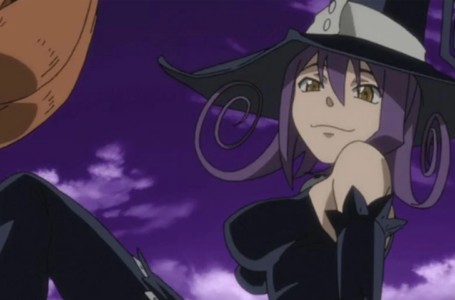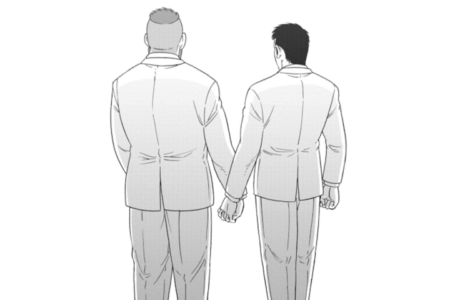Reaching an understanding in Love Me for Who I Am volume 5
At the end of volume 4 of Kata Konayama’s Love Me for Who I Am (also known as Fukakai na Boku no Subete o or FukaBoku), the fate of our protagonist Mogumo was unknown. Following a bitter argument with their sister Sakura that turned unintentionally violent, the last thing we saw was Mogumo lying on the floor, unresponsive and bleeding.
It was a striking and heartbreaking depiction of how people who find their gender identity diverging from their birth sex are faced with difficult challenges at every turn — up to and including violence against them, even from their own family members.
As shocking as the moment was, though, it was immediately clear that Sakura didn’t actually mean to harm Mogumo; she was trying to make a point, and the situation simply got out of hand as it unfolded in unexpected ways. While Sakura was shown throughout volume 4 of Love Me for Who I Am to have great difficulty in understanding Mogumo and their way of life, by the end of the volume there wasn’t genuine malice there — frustration and anger, maybe, but certainly no desire to see Mogumo hurt.
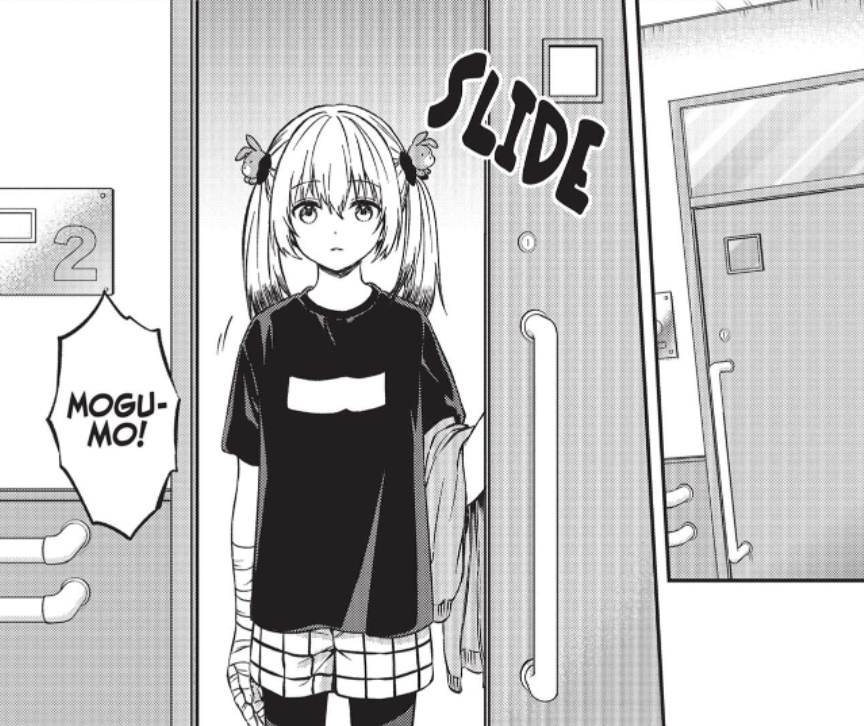
Thankfully, as the final volume of Love Me for Who I Am opens, we learn that Mogumo is just fine, and while they ended up with an injured hand and arm from the altercation with the knife, there was no lasting damage, and Mogumo doesn’t blame Sakura for the incident. Instead, they take it as an opportunity to explain some things that they’ve been keeping to themselves for quite some time — including the very situation that Sakura was “recreating” with the knife in an attempt to make a point about her own mental anguish.
We learn that Mogumo’s feelings of gender dysphoria extend right back to their childhood, when they describe themselves as “always loving cute things”. Mogumo was continually denied the cute things they desired on the grounds of them being considered a boy by their parents, and the things they wanted being “for girls”. Their protestations that they weren’t a boy fell on deaf ears, and thus in Mogumo’s childish brain, their main conclusion was that their parents loved Sakura more than them, because Sakura got everything she wanted without argument.
Mogumo’s gender dysphoria came to a real head when they first attended elementary school, and the students were asked to line up in two lines according to gender. Panicking, Mogumo joined the girls’ line, only to find that no-one felt they “belonged” there, and from there they describe themselves as continually “hitting the wall between boys and girls; everyone in my class probably thought I was some dimwitted weirdo”.
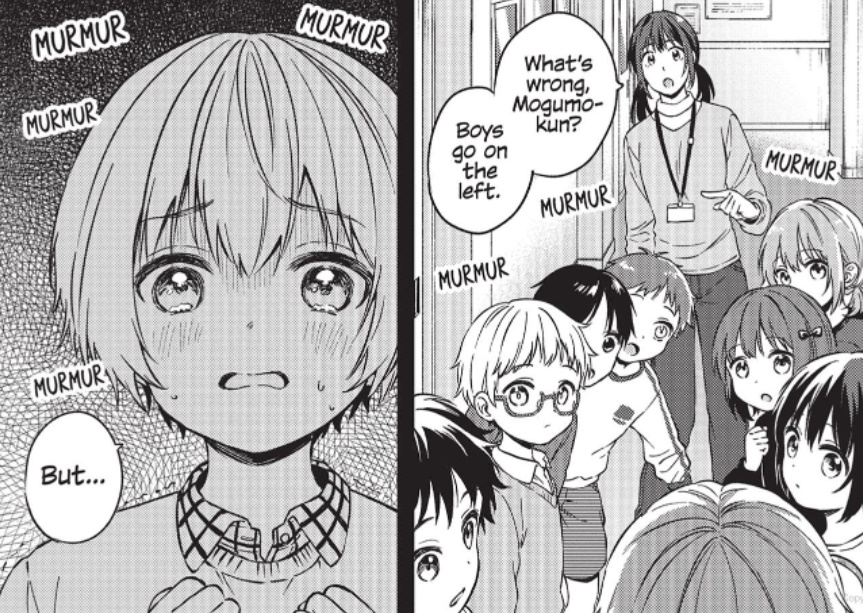
It’s at this point we come to understand the importance of Mogumo’s relationship with Kotone. Kotone became Mogumo’s friend and questioned their identity, but not in a malicious way — she simply wanted to understand them better. Of course, by this point in Love Me for Who I Am we know that this is because Kotone is also questioning and defining her own identity as a lesbian — a fact emphasised by how we see her harshly rebuffing prospective (male) suitors as early as elementary school — but Kotone herself hasn’t recognised and accepted this completely yet.
Mogumo recognises something of a kindred spirit in her, though — even if, as seen in the earlier volumes, this leads to a bit of a misunderstanding between them — and thus they become close friends, with Mogumo finally starting to establish the support network that they simply don’t have at home.
It’s also noteworthy at this point that Mogumo explains they prefer to use their family name (or feminine diminutive forms thereof, such as “Mogu-chan”) because they don’t like their first name.
Indeed, while they don’t give the specific reasons for this themselves, it becomes obvious why later in the volume: Mogumo’s father gave them the male-coded name “Ryuunosuke” (which can translate to “dragon”, “noble”, “prosperous” and various other strong words according to the specific kanji used) because he believed they could “live up to” such a masculine, strong name. Mogumo dislikes anything that reminds them of being a boy, and as such it’s natural they’d dislike such a name.
We also learn a bit about Sakura’s use of “Ryuu-chan” to refer to Mogumo; while her use of the typically feminine-coded diminutive honorific “-chan” is, on some level, an acknowledgement of Mogumo’s desire to not be considered a boy, her refusal to call them “Mogu-chan” is purely selfish in nature. She is the one who is “Mogu-chan”, and thus she believes “Ryuu-chan” is a suitable compromise. It’s perhaps better than nothing — it’s certainly better than her referring to them as “big brother”, as she sometimes does — but given Mogumo’s dislike of their given name, it doubtless provides a bit of a jab in the ribs every time she says it.
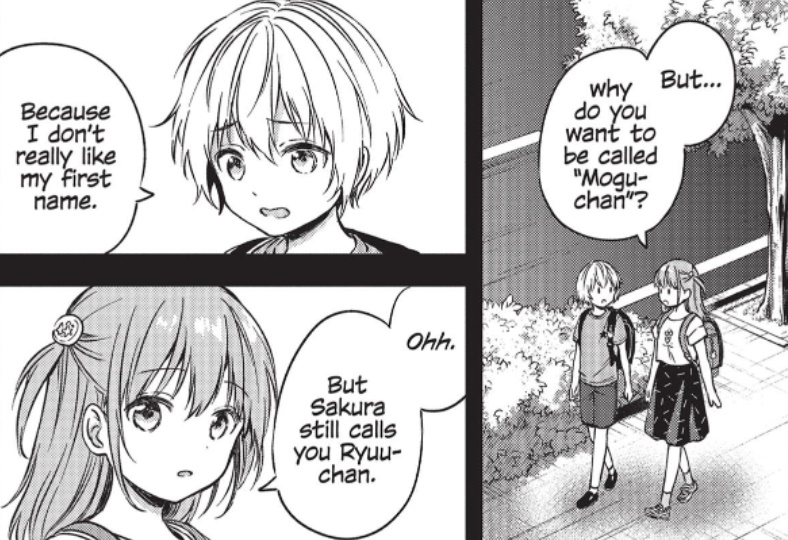
Finally, we come to a dramatic turning point in Mogumo’s life. Their father has gone away for a long-term work assignment, leaving Mogumo alone with their mother and sister. One might think this an ideal situation for Mogumo, since their father has always been the main one hammering home the importance of conforming to traditional gender roles and one’s birth sex — but it actually drives Mogumo to depression, anxiety and fits of violent rage.
Mogumo never explains this — perhaps they can’t — and so all we can do is attempt to interpret the situation with the information we’re given. The most likely explanations are that despite Mogumo continually clashing with their father, they still feel the need for a male role model in their life — and that those clashes with their father were an important part of them helping to define their own identity for themselves. While traumatic and upsetting at the time, those arguments afforded Mogumo an opportunity to state their case passionately and forcefully — even if it seemed impossible for them to “win”.
The critical moment comes when Mogumo is feeling ill with a sore throat, and their mother suggests that their “voice might be changing” — in other words, breaking with puberty. To Mogumo, who has been forcefully denying that they are a boy for a significant portion of their life at this point, this is unthinkable; a broken voice would, so far as they’re concerned, be an irrefutable sign that they are a boy, and as such completely unacceptable.
So, desperate to resolve the situation the only way they feel like they can in the heat of the moment, they take a knife and prepare to cut out their Adam’s apple, which they believe is the source of all their troubles.
Thankfully, their mother catches them in the act — though completely fails to understand exactly how the situation has managed to progress this far — and the eventual result is that Mogumo’s father has to come home early from his assignment, Mogumo’s mother falls into the depression we’ve seen her living up until this point throughout Love Me for Who I Am, and Mogumo is permitted to move out and attend a school where they are free to choose their uniform for themselves.

Mogumo feels intense guilt for what they did, and the situation with Sakura has made that abundantly clear for them. While it’s perhaps unfair to say that Mogumo’s identity is what tore their family apart — you are who you are, and that’s not something you can really control — they do at least recognise that their irrational behaviour and inability to cope with the situation is a direct contributing factor to the family’s present condition. And as such, they have a desire to make things right.
It’s a good time for Mogumo to have this thought. They are completely comfortable in their own gender identity, they have found friends among the staff of Café Question — and helped some of those friends come to terms with their own gender identity — and they have successfully established their own sexual identity also, by beginning an intimate relationship with Tetsu. They are in a good, comfortable, secure place in their own life, and so it stands to reason that they’d want to correct past mistakes — and hopefully find some acceptance from the people they most want to love them for who they are.
Mogumo’s friends are realistic about the situation, though. Mei, who has gradually come out as transgender rather than otokonoko over the course of Love Me for Who I Am’s five volumes, explains that while she was fortunate enough to have a family who understood and accepted her enough to allow her to live as a girl in her daily life, Mogumo’s family might not be quite so understanding. Indeed, everything we’ve seen up until this point makes it worryingly likely that they won’t listen to Mogumo, nor will they accept their identity.
“If they really love you,” Mei says, “maybe they’ll come around. But you do have one thing: us! You definitely shook things up when you came here, but eventually we all came together. More importantly, thanks to you, I was able to be my true self. If you can talk to your parents the same way, I know you can keep growing.”
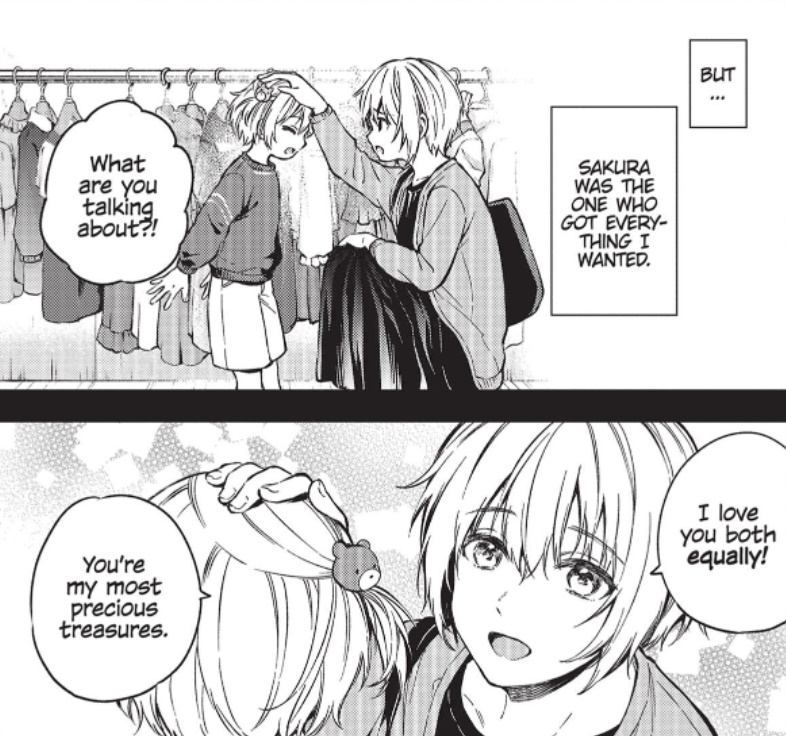
Tetsu also offers his help with the situation. As Mogumo’s boyfriend, he doesn’t wish to leave them alone to handle the situation by themselves, and he also figures that he has several key ways in which he can assist. Firstly, he helps Mogumo learn how to cook some simple dishes that they’ll be able to prepare for their family — a delicious meal is always a good means of lowering the tension ahead of a difficult conversation, after all — and secondly, he explains an incident from his own past that makes him uniquely qualified to assist with Mogumo’s upcoming challenge.
We’ve known from the beginning that Tetsu’s sister Sacchan — the owner and chef at Café Question — is a trans woman, but up until this point in Love Me for Who I Am, we’ve not heard a lot about the circumstances of how she and Tetsu became so seemingly comfortable and confident with their situation. We’ve had hints that both Sacchan and Tetsu suffered abuse at school for Sacchan’s gender identity and self-expression, but up until now, we haven’t heard a lot about the family side of things. Understandably so, as it turns out.
“When I was in elementary school,” Tetsu explains, “my sister came out to my parents and told them that she’s a girl. But my father couldn’t understand. We were normally a peaceful family, but that’s when the fighting started. As a child, they kept me out of it. My sister needed my help, but I couldn’t do anything. Things got worse after that. I know your family may not want an outsider getting involved, but maybe I can use my experience to help. Most importantly, I don’t want anyone else to suffer like my sister did back then. I can’t just watch and do nothing.”
Tetsu knows that he can’t just swoop in and “solve” the situation, and so he and Mogumo agree that he should turn up a little later in the evening, after Mogumo has had the opportunity to broach the subject somewhat. If things have gone well by that point, he can offer his own insights; if things are going poorly, meanwhile, the arrival of an outsider might help to defuse the situation a little.
Things start somewhat tense. While Mogumo’s mother is thrilled to see Mogumo — despite repeatedly referring to them as “Ryuunosuke” — their father’s immediate response is “why is your hair like that?”, referring to Mogumo’s distinctly feminine twintailed hairstyle. Mogumo almost immediately manages to smooth things over by revealing the meal that they cooked, however — which includes one of their father’s favourites.
Things seem to be going well when both of Mogumo’s parents agree to let them move back home and help out their mother as she continues to struggle with her mental health — that is, until Mogumo’s father imposes a condition on Mogumo’s return. That condition, of course, is for Mogumo to stop wearing their hair in a feminine style; indeed, as this chapter of Love Me for Who I Am closes, he threatens to take the scissors to Mogumo’s hair right then and there. But this, of course, is the perfect opportunity for Mogumo to explain everything — why their hair is like that, why they did the things they did, and why they are living the way they do now.
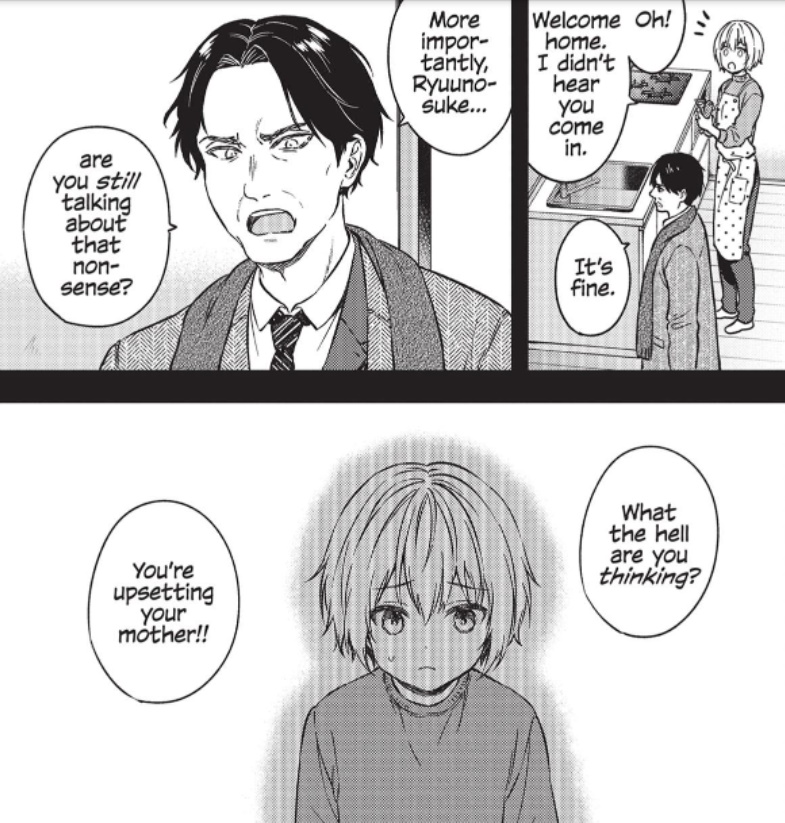
Mogumo’s father believes that Mogumo ended up the way they are because Mogumo’s mother was “overly permissive”. Therefore he took it upon himself to be extra-strict, and even ended up bonding with his own father over the difficulty of raising a seemingly uncooperative teenager. But his own teenage angst was different to Mogumo’s; while he had his own concerns over defining himself and felt frustration when his own father didn’t understand him, he wasn’t struggling with feelings of gender dysphoria. As such, when Mogumo explains the situation, he is immediately resistant to accepting it.
To Mogumo’s father, because he’s never heard of the concept of non-binary people, the concept simply doesn’t exist, and he believes that Mogumo is continuing to perpetuate a childish fantasy that tore the family apart. Mogumo, meanwhile, knows that they did wrong and apologises for it — but is keen to emphasise that while they are apologising for the traumatic sight of taking a knife to their own throat, they are not apologising for who they are.
“Ryuunosuke, you’re our only son,” their father says. “You’re our eldest.”
“So if I’m not a boy, you don’t want me?” Mogumo asks, quite reasonably.
“That’s not what I mean–” their father responds, clearly shaken, and it’s at this point, of course, that Tetsu turns up, drops the bombshell that he and Mogumo are lovers and completely alters the dynamic of what’s going on — for the better. It was a big risk to be as forthright as he was, but the confidence and passion both he and Mogumo display are enough to actually shut up Mogumo’s father for a moment and make him listen.
“My older sister is transgender,” Tetsu explains; Mogumo’s father, of course, has no idea what this is. “Are you familiar with gender dysphoria? It’s used to describe what someone feels when their sex assigned at birth doesn’t match their gender identity. My sister is one of those people. For years, I called her my brother. But now I know that she’s my sister.
“She was assigned male at birth,” he continues, “but her mind… her identity was female. That disparity caused her so much anxiety, but now that she lives as a woman, she meets every day with enthusiasm, and our family can smile again. Even if her clothes and hair are different, whether she’s my brother or sister, she’s still a precious member of our family. And that is true for Mogumo-san as well. Really, I just want you all to accept Mogumo-san as they are. They won’t become a different person.”
Mogumo’s father still won’t accept this, of course; it’s not until Mogumo’s mother steps in with uncharacteristic assertiveness and demands that he listen that he finally starts to pay attention. She tells him about a transgender man she met at the clinic she attends, and how this individual, noticing her non-malicious curiosity — and her apparent desire to talk about Mogumo, but her hesitance to follow through on her questions — was happy to sit down with her and explain the basics, as well as point her in the direction of some suitable reading material to find out a little more about this world she knew nothing about.
Mogumo’s father knows that he’s beaten… and indeed, it comes to light that his obsession with being “the strict parent” had, in fact, somewhat overtaken his own ability to be rational about the situation. When confronted with seemingly his entire family willing to at least listen to Mogumo, he has no choice but to acquiesce — the only alternative, of course, is for him to walk out of the door and never come back. And it’s clear that he doesn’t really want that.
“Dad,” Mogumo says, “I know you might hate how I look, but I love Mom, I love Sakura, and I love you. I never hated you. Not once. Thank you for giving me this life, just as I am. For giving me the chance to meet people who are precious to me.”
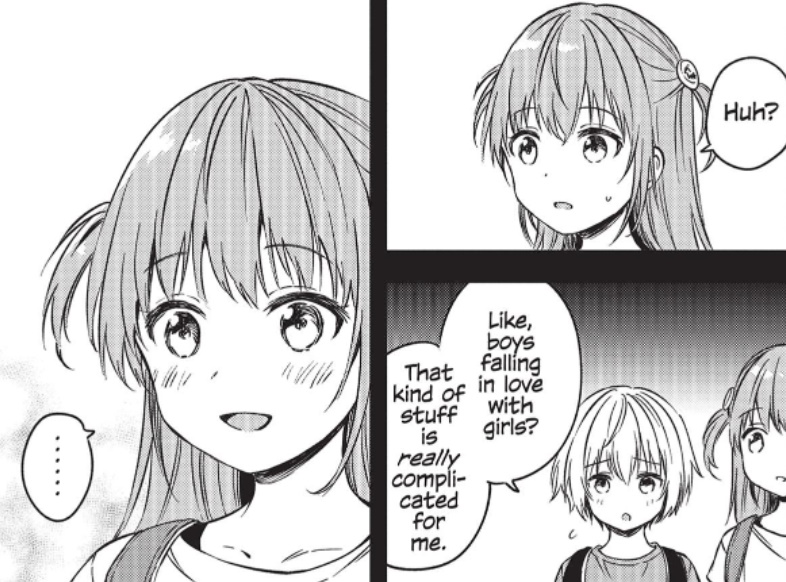
It’s a powerful resolution to the situation, to be sure. And it also (perhaps unintentionally?) mirrors how the entirety of Love Me for Who I Am can quite reasonably be used as a learning opportunity. Much as Mogumo’s mother learned a great deal from spending time with her transgender acquaintance and reading the material they recommended, so too can all of us learn from the time we’ve spent with Mogumo and their friends.
Whether it’s Mogumo’s struggle to make people understand their own position, Mei’s gradual progression from otokonoko to transgender woman, Sacchan’s complete embracing of their transgender identity, Suzu’s dressing as a woman to make their relationship with a male classmate easier for everyone around them to deal with, or any of the many other stories this series has to tell, there’s a lot to learn from Love Me for Who I Am.
Most of those lessons can be summed up quite simply, mind: people are who they are, and the only person who can truly define them is themselves. So you may as well love them for who they are.
Love Me for Who I Am volume 4 is available in paperback and Kindle format from Amazon. Alternative digital versions and physical retailers are listed on Seven Seas’ website.
Join The Discussion
Rice Digital Discord
Rice Digital Twitter
Rice Digital Facebook
Or write us a letter for the Rice Digital Friday Letters Page by clicking here!
Disclosure: Some links in this article may be affiliate links, which means we may earn a small commission if you make a purchase after clicking on them. This is at no additional cost to you and helps support Rice Digital!
- Letter from the Editor: passing the torch - June 30, 2023
- Super Woden GP 2 is looking promising - June 30, 2023
- Inti Creates is making a 32 bit-style Love Live action platformer - June 26, 2023





